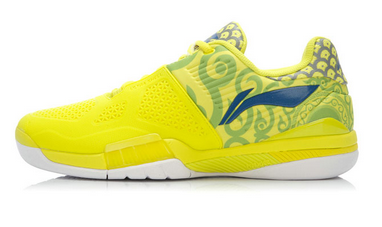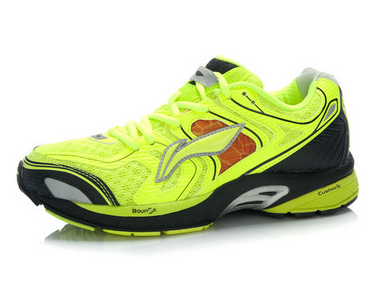You think the running shoe debate is over? That minimalist and barefoot running had its feet crushed by “fee-fi-fo-fum” footwear giants? Just wait, and the pendulum will some day swing back to less shoe. How long the wait? Five, ten years? Which isn’t that long considering that the modern running shoe is a half-century old. (How many readers still have their old Onitsuka Tigers buried in their closets, relics of high-school or college cross-country?)
One hopeful way not to cede any more ground to the “more shoe is best” majority is to bring up a very apt and relevant comparison. Look at these two shoes from China sports footwear giant Li Ning. The top photo is the Marin Cilic Running Shoe; the bottom photo is the Marin Cilic Tennis Shoe. For those who don’t know who Cilic is, he’s a 28-year-old professional tennis star from Croatia, ranked eighth in the world in 2014, and reached the semi-finals at the 2015 U.S. Open.
 Why is the tennis shoe zero drop? And why does the running shoe feature a built-up heel, thicker sole, more cushioning, and pronounced rigidity? A tennis player runs an average of three miles per five-set match, and the mileage can certainly increase if both players keep the ball in play over long rallies and extended tiebreakers. All of this running, frequently stopping and starting with jagged directional changes, takes place inside a court that’s only 27 feet wide for singles.
Why is the tennis shoe zero drop? And why does the running shoe feature a built-up heel, thicker sole, more cushioning, and pronounced rigidity? A tennis player runs an average of three miles per five-set match, and the mileage can certainly increase if both players keep the ball in play over long rallies and extended tiebreakers. All of this running, frequently stopping and starting with jagged directional changes, takes place inside a court that’s only 27 feet wide for singles.
Shouldn’t the Cilic tennis shoe be designed more like its running shoe counterpart? Better yet, why isn’t the Cilic running shoe designed more like its tennis shoe counterpart? It should be noted that almost all tennis shoe brands are zero drop, and do not have an outsized heel.
To make sense of this discrepancy (confusion?) the NRC sought the knowledge of running shoe expert Jim Hixson, a frequent contributor to this site and author of the popular three-part series, “Why Minimalism Flatted.” Jim has been in the retail shoe business for over 20 years. He was wearing (and advocating) minimalist shoes several years before Born to Run was published.—Bill Katovsky
***
Shoe vs. Shoe: Minimalist and Conventional Running Shoes
By Jim Hixson
It’s not surprising that tennis shoes and all other athletic shoes, with the exception of Olympic weightlifting shoes, are zero drop (there is no extra rise between the heel and toebox). All athletes want to be in a stable position, both when standing and moving, and they want to be able to change speed and direction quickly. An athletic shoe with a heel doesn’t allow these goals to be satisfied.
If tennis players wore a pair of conventional running shoes, they would be pitched forward and unable to maintain proper technique and balance, not only when moving diagonally, laterally, and backwards, but also forward. Even when running directly towards the net, a tennis player would feel uncomfortable, uneasy, and off-balance in a running shoe.
It’s the same story with soccer players and their shoes (“football” and “boots” for anglophiles). Not only would soccer players be unable to play well while wearing shoes with heels, they would be at greater risk of injury, both traumatic, such as ankle sprains and ACL tears, and “running-related injuries” (RRI): shin splints, plantar fasciitis, patellofemoral pain, iliotibial band syndrome, etc.
There are many examples of athletes from other sports never having an RRI until they began to wear modern running shoes.
Several years ago a runner came to the St. Louis store I was managing. He complained of terrible shin splints. He wasn’t interested in buying shoes; he just wanted our store’s recommendation for an orthopedist or physical therapist. I asked him to run down the sidewalk in the pair of stability shoes he was wearing, which had been recommended to him at another store, because he was a “mild over-pronator.” He was wearing a stability shoe, either a Brooks Adrenaline or ASICs GT2000 series, both with 12mm drops.
After running just a few steps it was obvious that his pain was being caused by overstriding and heel-striking; in fact, he winced each time his heel came into contact with the cement.
This customer looked very fit, much fitter than an average recreational runner, but he wasn’t running athletically at all, so I asked him a few questions.
“What is your athletic background,” I asked.
“I played soccer for most of my life,” he replied.
“At what level did you play?” I inquired.
“I competed through college and actually played pro soccer in Europe for a couple of years,” he responded.
“Why aren’t you running the way you did while you were playing soccer?” I wondered aloud.
“Because distance running is a different type of running,” he answered. “I was told to hit heel first and let my foot roll through to the next step.
At this point I could have said: “No, you’re wrong, absolutely, completely, and incredibly wrong. I have no idea who fed you that nonsense. Perhaps you were looking at catalogs or magazine ads from running shoe companies that invariably feature runners with foolish grins who are not only heel striking, but overstriding to the point where they might attempt the splits.
Instead, I said:“No, actually the technique you use while running as a sport should be the same one you use when running in a sport. Run down the sidewalk again, but run as if you were in a soccer game, not sprinting, just run as if you were moving into position to receive a pass from another player.”
And that is what he did.
He ran down the sidewalk with perfect form, striking midfoot with his heel barely off the ground. After his heel settled and touched the ground he smoothly sprung forward into the next step. The fluidity of his stride easily identified him as an elite athlete. What was stronger evidence of the correctness of his technique was the smile on his face as he returned.
“I have no shin splints. They’re gone!” he exclaimed.
“They will be gone as long as you run correctly,” I said. “You don’t need a medical recommendation, just a shoe with no heel, so it will be easier for you to run correctly, the way you ran as a soccer player.”
As a starting point in any discussion about running technique one would suppose that runners want to be able to move quickly, safely, and efficiently.
Having a heeled shoe changes the body’s natural biomechanics and nobody in the world can prove that it doesn’t. So, in order to justify a heeled shoe it has to be proven that in the case of running altered biomechanics are superior to natural biomechanics. With apologies to those who see some advantage in wearing running shoes with heels, even 4mm “transitional” shoes, that claim can’t be proven, although it can be disproven.
This is how the argument for wearing a heeled running shoe usually goes, when the unnaturalness of a heel is exposed by a critic.
Perhaps it’s true that runners don’t need a shoe with an elevated, cushioned heel, maybe this feature is even unnatural, but the fact that many people do run heel first requires a shoe with a cushioned heel.
I really find it difficult to continue a discussion with someone who uses such misguided, specious reasoning. If a major factor contributing to poor running technique is the inherently flawed construction of the modern running shoe, shouldn’t we be changing the design of the shoe, rather than trying to reduce some of the discomfort associated with poor technique?
By now it should be clear that much of the pain and discomfort associated with poor technique is strongly influenced by unnecessary features such as cushioned elevated heels, stable midsoles, “corrective” medial support, and a narrow footbed that does not naturally match the runner’s foot.
Running shoe companies have so much invested in the classic design of modern running shoes, that they will never willingly change the popular style. Colors will change, soles will get thicker, and heels even larger. Some noticeable changes were forced by the popularity of minimal running shoes several years ago, but once that media attention died down sufficiently, shoe companies were more or less able to reestablish and justify their old designs.
The heel drop is only one of the characteristics of modern shoes that have pronounced negative effects on natural biomechanics. A zero-drop shoe with a thick, cushioned insole is better than a shoe with an elevated cushioned heel, but the thick cushioning prevents the body from receiving information from the running surface accurately and quickly. A shoe that is stiff prevents the many of the muscles of the foot and lower leg from being fully engaged. This is especially true for the smaller intrinsic muscles of the foot, which are essential for supporting the plantar fascia.
The relationship between a shoe and the foot should be the same as the one between a glove and the hand: protection from dangerous surfaces or elements while preserving as much information as possible. If anything the human body is sensing machine that seeks information to maintain safety and be efficient
The more one argues the case for wearing minimal shoes as a primary and effective way to encourage proper running technique, the greater, as I’ve come to realize, is that the real resistance has less to do with actual running and more to do with the human nature of runners.
The still-heated conversations about running shoes have often made me think of Copernicus and Galileo, although they were arguing under a bit more pressure (like death threats.) If a salesperson in a running store explains why the features of modern running shoes (pronation control with elevated cushioned heel) are necessary, his or her logic makes sense, but when you question the evidence on which that argument is based the logic falls apart. When someone 500 years ago explained why the sun rotated around the earth, based upon the incorrect observation that the sun is rising in the morning and setting in the evening, the geocentric theory made sense; but once you placed the sun, not the earth, at the center of our solar system, the entire illogical edifice crumbles.
Advertising, marketing, habit, flawed science and lab testing, and commercial inertia have sustained the current design of modern running shoes, not by evidence or even common sense. To borrow a term from tennis, it’s been foot fault for decades.




Hi,
I use to run with minimalist shoes (Vivobarefoot, Inov-8, FiveFingers) and I play tennis too.
How can you compare 2 sports so different ?… When you play tennis you must be on the forefeet, ready to start quickly on any direction like a sprinter, but you spend most of the time walking between two points, and the ground is flat and safe 🙂 When you run you never stop, during hours (except if you run less then 15km …), on trail running you must be careful because of rocks, you jump, you go up and down. Would you take the same bike for 100km on the road and 10km downhill ?
I agree with minimalism, but please do not make such comparison because for people who don’t appreciate minimalism it’s too easy to reply that you are wrong …
Antoine
You’re missing the point completely. The biomechanics of efficient movement are the same for tennis when the direction is forwards; obviously lateral movement does not occur in distance running, nor does backwards running. Running forward in soccer requires the same biomechanics as running forward in distance running. Remember that fast running, even very fast running, is not necessarily sprinting. In fact, if you watch an elite sprinter in slow motion you will realize that very few people will ever sprint. It makes no biomechanical sense to ever run heel first unless you’re trying to stop, in which case you are not trying to maintain movement. Running is an open-ended series of submaximal alternating one-legged forward hops/jumps. OK, try to hop forward from one leg to the other just 3-4 times, but try to land one of your heels each time. If you really think there is more than one way to a basic human movement pattern like running, maybe we should apply that line of thinking to another one basic movement pattern: walking. I would argue that humans naturally walk heel first and that normally walking on the balls of the feet is not correct technique. I don’t think riding a bike with the heel of the shoe on the pedal correct technique. And I don’t think swimming with the heel of the hand making initial contact with the water is correct technique. Individuals who practice deadlifts or squats should not round their backs. We accept the fact that there are correct movement patterns for just about every activity, except running. You really have to argue that running is the only activity that is not subject to biomechanical laws or analysis.
Way to go, Jim. So true: “Remember that fast running, even very fast running, is not necessarily sprinting. In fact, if you watch an elite sprinter in slow motion you will realize that very few people will ever sprint.” –bill k
Heels are *LARGELY* a fad that never went away. You need a heel or something like that to partially secure your foot in a stirrup of a saddle and similar things. Otherwise, you DO NOT NEED A HEEL.
If you’re horseback riding or working in a context where you might be expected to do that, say at like a horse show, you should have a heeled shoe for that activity. Otherwise, you should have something that rids yourself of it.
Shoes are protective coverings that should mirror the activity you’re currently doing. If you’re not horseback riding…why are you using a heel?
If you’re not working in an environment where you might get stepped on by a horse or the like or drop something heavy on your foot…why do you need “boots”?